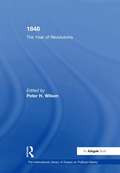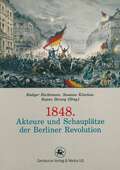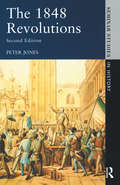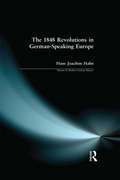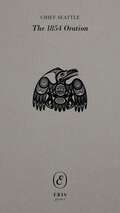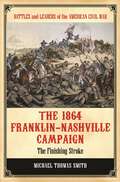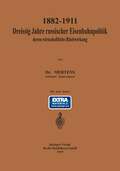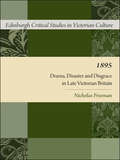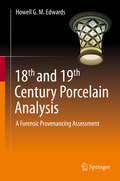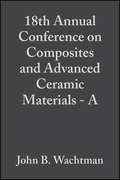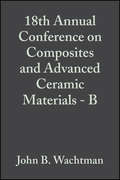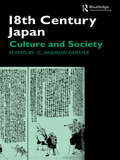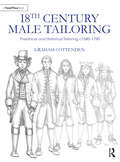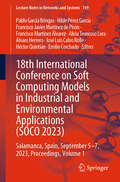- Table View
- List View
1848: The Year of Revolutions (The International Library of Essays on Political History)
by Peter H. WilsonEurope was swept by a wave of revolution in 1848 that had repercussions stretching well beyond the Continent. Governments fell in quick succession or conceded significant reforms, before being rolled back by conservative reaction. Though widely perceived as a failure, the revolution ended the vestiges of feudalism, broadened civil society and strengthened the state prior to the rapid industrialisation and urbanisation of the latter part of the nineteenth century. This volume brings together essays from leading specialists on the international dimension, national experiences, political mobilisation, reaction and legacy.
1848: The Year of Revolutions (The International Library of Essays on Political History)
by Peter H. WilsonEurope was swept by a wave of revolution in 1848 that had repercussions stretching well beyond the Continent. Governments fell in quick succession or conceded significant reforms, before being rolled back by conservative reaction. Though widely perceived as a failure, the revolution ended the vestiges of feudalism, broadened civil society and strengthened the state prior to the rapid industrialisation and urbanisation of the latter part of the nineteenth century. This volume brings together essays from leading specialists on the international dimension, national experiences, political mobilisation, reaction and legacy.
1848 — A European Revolution?: International Ideas and National Memories of 1848
by A. KörnerThis book is among the rare contributions to the 150th anniversary of 1848 which takes a completely new, theoretically informed approach. Instead of a traditional social or political history, the authors analyse the dichotomy between the international dimension in the ideas of the revolution and the nationalisation of memories in its commemorations over the past 150 years. The book offers original research on the history of European ideas and takes part in the current debate about the relationship between history and memory.
1848. Akteure und Schauplätze der Berliner Revolution (Reihe revolution revisited #1)
by Rüdiger Hachtmann Susanne Kitchun Rejane HerwigAls einzige Revolution des 19. und 20. Jahrhunderts besaß die Revolution von 1848/49 eine gesamteuropäische Dimension. Sie erfasste zahllose Menschen und kannte viele Bühnen, an allen europäischen Brennpunkten des Jahres 1848. Dieses Buch setzt Schlaglichter, exemplarisch für die preußische Hauptstadt, die neben Paris und Wien von März bis November 1848 die europäische Revolutionsmetropole war. Manfred Gailus wendet sich der wichtigsten sozialen Trägergruppe der städtischen Revolutionsbewegung zu, den sozialen Unterschichten, und stellt deren typische Politik- und Protestformen vor. Rüdiger Hachtmann zeigt, dass die Revolution von 1848 auch ausgeprägte Züge einer Jugendrebellion trug und insbesondere innerhalb des Bürgertums auch Ausdruck eines Generationenkonflikts war. Sylvia Paletschek widmet sich der Rolle der Frauen im revolutionären Geschehen und geht exemplarisch auf eine junge Frau ein, die 1848 in Berlin zu einer Ikone auch der revolutionär gestimmten Männer wurde, nach der Revolution jedoch je nach Perspektive als Heiratsschwindlerin, Hochstaplerin oder Spionin galt. Christian Jansen zeigt an Einzelschicksalen, dass ganz ähnlich wie die Achtundsechziger des 20. Jahrhunderts auch die Achtundvierziger des 19. Jahrhunderts ein starkes generationelles Zusammengehörigkeitsgefühl zeigten, auch wenn sie politisch sehr unterschiedliche Wege einschlugen.Der Band ist aus Vorträgen hervorgegangen, die im Rahmen der 2011 eröffneten Ausstellung „Am Grundstein der Demokratie. Die Revolution 1848 und der Friedhof der Märzgefallenen“ im Berliner Friedrichshain gehalten wurden. Die Reihe soll fortgesetzt werden.
The 1848 Revolutions
by Peter JonesIn 1848 revolutions broke out all over Europe - in France, the Habsburg and German lands and the Italian peninsular. This Seminar Study considers why the revolutions occurred and why they were so widespread. The book offers a broad ranging investigation of the social, economic and political circumstances which led to the revolutions of 1848 as well as an account of the revolutions themselves. First published in 1981, and fully revised in 1991, the study has long established itself as one of the most accessible and valuable introductions to this complex subject.
The 1848 Revolutions
by Peter JonesIn 1848 revolutions broke out all over Europe - in France, the Habsburg and German lands and the Italian peninsular. This Seminar Study considers why the revolutions occurred and why they were so widespread. The book offers a broad ranging investigation of the social, economic and political circumstances which led to the revolutions of 1848 as well as an account of the revolutions themselves. First published in 1981, and fully revised in 1991, the study has long established itself as one of the most accessible and valuable introductions to this complex subject.
The 1848 Revolutions in German-Speaking Europe (Themes In Modern German History)
by H. J. HahnIn 1848 the continent of Europe was rocked by revolutions: only Great Britain and Russia remained relatively immune to the upheaval. Most spectacularly, the Revolutions swept across the German-speaking lands of central Europe, with the newly-released forces of nationalism and mass popular protest smashing the reactionary Metternich regimes which had held sway since the defeat of Napoleon. The Metternich system was dead: nationalism and national self-determination asserted themselves as the dominant dynamic forces of continental Europe in the later nineteenth century. This impressive history examines the political and social implications of the 1848 Revolutions for the future destiny and shape of Europe as a whole, and explores the wider forces at play in the German lands of nineteenth-century Europe.
The 1848 Revolutions in German-Speaking Europe (Themes In Modern German History)
by H. J. HahnIn 1848 the continent of Europe was rocked by revolutions: only Great Britain and Russia remained relatively immune to the upheaval. Most spectacularly, the Revolutions swept across the German-speaking lands of central Europe, with the newly-released forces of nationalism and mass popular protest smashing the reactionary Metternich regimes which had held sway since the defeat of Napoleon. The Metternich system was dead: nationalism and national self-determination asserted themselves as the dominant dynamic forces of continental Europe in the later nineteenth century. This impressive history examines the political and social implications of the 1848 Revolutions for the future destiny and shape of Europe as a whole, and explores the wider forces at play in the German lands of nineteenth-century Europe.
The 1854 Oration (ERIS Gems)
by Chief Seattle"It matters little where we pass the remnant of our days. They will not be many". A powerful lament for an imperilled way of life, the 1854 speech traditionally attributed to Chief Seattle of the Duwamish Tribe is a vital document in the history of the Indigenous peoples of North America. Chief Seattle's oration was delivered in the face of the impending loss of his people's land to the State of Washington, and it remains a profound meditation on the nature of time, colonialism, and religion.
The 1864 Franklin-Nashville Campaign: The Finishing Stroke (Battles and Leaders of the American Civil War)
by Michael Thomas SmithThis appealing narrative history of one of the Civil War's most pivotal campaigns analyzes how the western Confederate army under John B. Hood suffered a devastating defeat at the hands of George H. Thomas's Union forces.Ideal for general readers interested in military history of the Civil War as well as those concentrating on the western campaigns, The 1864 Franklin-Nashville Campaign: The Finishing Stroke examines how the strategic and tactical decisions by Confederate and Union commanders contributed to the smashing Northern victories in Tennessee in November–December 1864. The book also considers the conflict through the lens of New Military History, including the manner in which the battles both affected and were affected by civilian individuals, the environment, and common soldiers such as Confederate veteran Sam Watkins. The result of author Michael Thomas Smith's extensive research into the Civil War and his recognition of inadequate coverage of the final western campaigns in the existing literature, this work serves to rectify this oversight. The book also questions the concept of the outcome of the Civil War as being essentially attributable to superior Northern organization and management—the "organized war to victory" theory as termed by its proponents.
The 1864 Franklin-Nashville Campaign: The Finishing Stroke (Battles and Leaders of the American Civil War)
by Michael Thomas SmithThis appealing narrative history of one of the Civil War's most pivotal campaigns analyzes how the western Confederate army under John B. Hood suffered a devastating defeat at the hands of George H. Thomas's Union forces.Ideal for general readers interested in military history of the Civil War as well as those concentrating on the western campaigns, The 1864 Franklin-Nashville Campaign: The Finishing Stroke examines how the strategic and tactical decisions by Confederate and Union commanders contributed to the smashing Northern victories in Tennessee in November–December 1864. The book also considers the conflict through the lens of New Military History, including the manner in which the battles both affected and were affected by civilian individuals, the environment, and common soldiers such as Confederate veteran Sam Watkins. The result of author Michael Thomas Smith's extensive research into the Civil War and his recognition of inadequate coverage of the final western campaigns in the existing literature, this work serves to rectify this oversight. The book also questions the concept of the outcome of the Civil War as being essentially attributable to superior Northern organization and management—the "organized war to victory" theory as termed by its proponents.
1882–1911 Dreißig Jahre russischer Eisenbahnpolitik und deren wirtschaftliche Rückwirkung
by Elke MertensDieser Buchtitel ist Teil des Digitalisierungsprojekts Springer Book Archives mit Publikationen, die seit den Anfängen des Verlags von 1842 erschienen sind. Der Verlag stellt mit diesem Archiv Quellen für die historische wie auch die disziplingeschichtliche Forschung zur Verfügung, die jeweils im historischen Kontext betrachtet werden müssen. Dieser Titel erschien in der Zeit vor 1945 und wird daher in seiner zeittypischen politisch-ideologischen Ausrichtung vom Verlag nicht beworben.
1888: London Murders in the Year of the Ripper
by Peter StubleyIn 1888 Jack the Ripper made the headlines with a series of horrific murders that remain unsolved to this day. But most killers are not shadowy figures stalking the streets with a lust for blood. Many are ordinary citizens driven to the ultimate crime by circumstance, a fit of anger or a desire for revenge. Their crimes, overshadowed by the few, sensational cases, are ignored, forgotten or written off. This book examines all the known murders in London in 1888 to build a picture of society. Who were the victims? How did they live, and how did they die? Why did a husband batter his wife to death after she failed to get him a cup of tea? How many died under the wheels of a horse-driven cab? Just how dangerous was London in 1888?
1895: Drama, Disaster and Disgrace in Late Victorian Britain (Edinburgh Critical Studies in Victorian Culture (pdf))
by Nicholas FreemanExplores the lasting cultural and political impact of the events of this remarkable year Oscar Wilde's libel suit against the Marquess of Queensberry and its disastrous repercussions dominated British newspapers during the spring of 1895, but as this innovative study reveals, the Wilde scandal was by no means the only event to capture the public's imagination that year. Freak weather, a flu epidemic, a General Election, industrial unrest, 'sex novels' and New Women, trials of murderers and fraudsters, accidents, anarchists, bombers, balloonists and bicyclists were all topics of interest and alarm. Had Jack the Ripper returned? Did the Prime Minister have a dreadful secret? Were Aubrey Beardsley's drawings corrupting the nation's morals? Were overpaid foreign players corrupting English football? Could cricket save a degenerate nation from moral ruin? Drawing on strikingly diverse primary sources, Nicholas Freeman examines the recurrent preoccupations of a turbulent year, showing how 1890s' Britain is at once far removed from our own day and yet strangely familiar.
1895: Drama, Disaster and Disgrace in Late Victorian Britain (Edinburgh Critical Studies in Victorian Culture (pdf))
by Nicholas FreemanExplores the lasting cultural and political impact of the events of this remarkable year, which included Oscar Wilde's libel suit against the Marquess of Queensberry and its disastrous repercussions.
18th and 19th Century Porcelain Analysis: A Forensic Provenancing Assessment
by Howell G. EdwardsThis book addresses the contributions made by analytical chemistry to the characterisation of 18th and early 19th Century English and Welsh porcelains commencing with the earliest reports of Sir Arthur Church and of Herbert Eccles and Bernard Rackham using chemical digestion techniques and concluding with the most recent instrumental experiments, which together span more than a hundred years of study. From the earliest experiments which required necessarily the sacrifice of significant portions of each specimen, which may already have been damaged , to the latest experiments which needed only microsampling or the non-destructive interrogation of valuable perfect specimens a comprehensive survey is undertaken of more than twenty manufactories of quality porcelains. The correlation is made between the quantitative elemental oxide determinations of the scanning electron microscopic diffraction and Xray fluorescence data and the qualitative molecular spectroscopic Raman data to demonstrate their complementarity and use in the holistic forensic assessment of the origin of the fired procelains ; this will form the groundwork for the adoption of analytical techniques for the attribution of unknown or questionable procelains to their potential source factories . The book will also examine the perception of what constitutes a porcelain and its definitions and examines the assignment of porcelains to types which currently employs the definitions of hard paste , soft paste , hybrid , magnesian and bone china from the conclusions derived from the analytical data and a consideration of the raw materials employed in their manufacturing processes. During the discussion of this analytical evidence several themes and protocols have been established for its utilisation in the potential identification of porcelains and several case studies undertaken for this purpose are cited. The book will be of interest to analytical scientists , to museum ceramics curators and to ceramics historians.
18th Annual Conference on Composites and Advanced Ceramic Materials - A (Ceramic Engineering and Science Proceedings #176)
by John B. WachtmanThis volume is part of the Ceramic Engineering and Science Proceeding (CESP) series. This series contains a collection of papers dealing with issues in both traditional ceramics (i.e., glass, whitewares, refractories, and porcelain enamel) and advanced ceramics. Topics covered in the area of advanced ceramic include bioceramics, nanomaterials, composites, solid oxide fuel cells, mechanical properties and structural design, advanced ceramic coatings, ceramic armor, porous ceramics, and more.
18th Annual Conference on Composites and Advanced Ceramic Materials - B (Ceramic Engineering and Science Proceedings #178)
by John B. WachtmanThis volume is part of the Ceramic Engineering and Science Proceeding (CESP) series. This series contains a collection of papers dealing with issues in both traditional ceramics (i.e., glass, whitewares, refractories, and porcelain enamel) and advanced ceramics. Topics covered in the area of advanced ceramic include bioceramics, nanomaterials, composites, solid oxide fuel cells, mechanical properties and structural design, advanced ceramic coatings, ceramic armor, porous ceramics, and more.
18th Century Japan: Culture and Society
by C. Andrew GerstleThe period of Japanese history before the advent of industrialisation and modernism is of tremendous interest. The essays in this collection show a fascination with the social context behind the development of aesthetics, drama, language, art and philosophy, whether it be the world of the pleasure quarters or the Shogun's court.
18th Century Japan: Culture and Society
by C. Andrew GerstleThe period of Japanese history before the advent of industrialisation and modernism is of tremendous interest. The essays in this collection show a fascination with the social context behind the development of aesthetics, drama, language, art and philosophy, whether it be the world of the pleasure quarters or the Shogun's court.
18th Century Male Tailoring: Theatrical and Historical Tailoring c1680 – 1790
by Graham Cottenden18th Century Male Tailoring: Theatrical and Historical Tailoring c1680 – 1790 introduces the reader to English eighteenth-century tailoring and covers the drafting of patterns, cutting out in cloth and construction techniques in sequence for the tailoring of waistcoats, breeches and coats. From choosing the right cloth to preparing for the fitting process, this how-to guide will help readers create beautiful, historically accurate eighteenth-century male garments for events and performances. The book contains the following: step-by-step instructions complete with illustrations for students and costumiers who are new to the making of male tailored garments from the eighteenth century; drafting blocks and construction techniques for the different styles through the eighteenth century and patterns, photographs, detailed measurements and articles taken from a variety of male coats, waistcoats and trousers from c1680 – c1790 from museums and collections. 18th Century Male Tailoring is written for costume design and construction students, fashion students and practitioners who have a reasonable working knowledge of sewing and general costume making, but not necessarily of tailoring, drafting patterns, cutting skills and the making of male garments.
18th Century Male Tailoring: Theatrical and Historical Tailoring c1680 – 1790
by Graham Cottenden18th Century Male Tailoring: Theatrical and Historical Tailoring c1680 – 1790 introduces the reader to English eighteenth-century tailoring and covers the drafting of patterns, cutting out in cloth and construction techniques in sequence for the tailoring of waistcoats, breeches and coats. From choosing the right cloth to preparing for the fitting process, this how-to guide will help readers create beautiful, historically accurate eighteenth-century male garments for events and performances. The book contains the following: step-by-step instructions complete with illustrations for students and costumiers who are new to the making of male tailored garments from the eighteenth century; drafting blocks and construction techniques for the different styles through the eighteenth century and patterns, photographs, detailed measurements and articles taken from a variety of male coats, waistcoats and trousers from c1680 – c1790 from museums and collections. 18th Century Male Tailoring is written for costume design and construction students, fashion students and practitioners who have a reasonable working knowledge of sewing and general costume making, but not necessarily of tailoring, drafting patterns, cutting skills and the making of male garments.
18th Edition IET Wiring Regulations: Wiring Systems and Fault Finding for Installation Electricians, 7th ed
by Brian ScaddanThis book deals with an area of practice that many students and non-electricians find particularly challenging. It explains how to interpret circuit diagrams and wiring systems, and outlines the principles of testing before explaining how to apply this knowledge to fault finding in electrical circuits. A handy pocket guide for anybody that needs to be able to trace faults in circuits, whether in domestic, commercial or industrial settings, this book will be extremely useful to electricians, plumbers, heating engineers and intruder alarm installers.
18th International Conference on Soft Computing Models in Industrial and Environmental Applications: Salamanca, Spain, September 5–7, 2023, Proceedings, Volume 2 (Lecture Notes in Networks and Systems #750)
by Pablo García Bringas Hilde Pérez García Francisco Javier Martínez de Pisón Francisco Martínez Álvarez Alicia Troncoso Lora Álvaro Herrero José Luis Calvo Rolle Héctor Quintián Emilio CorchadoThis book of Advances in Intelligent and Soft Computing contains accepted papers presented at SOCO 2023 conference held in the beautiful and historic city of Salamanca (Spain) in September 2023.Soft computing represents a collection or set of computational techniques in machine learning, computer science, and some engineering disciplines, which investigate, simulate, and analyze very complex issues and phenomena.After a through peer-review process, the 18th SOCO 2023 International Program Committee selected 61 papers which are published in these conference proceedings and represents an acceptance rate of 60%. In this relevant edition, a particular emphasis was put on the organization of special sessions. Seven special sessions were organized related to relevant topics such as: Time Series Forecasting in Industrial and Environmental Applications, Technological Foundations and Advanced Applications of Drone Systems, Soft Computing Methods in Manufacturing and Management Systems, Efficiency and Explainability in Machine Learning and Soft Computing, Machine Learning and Computer Vision in Industry 4.0, Genetic and Evolutionary Computation in Real World and Industry, and Soft Computing and Hard Computing for a Data Science Process Model. The selection of papers was extremely rigorous to maintain the high quality of the conference. We want to thank the members of the Program Committees for their hard work during the reviewing process. This is a crucial process for creating a high-standard conference; the SOCO conference would not exist without their help.
18th International Conference on Soft Computing Models in Industrial and Environmental Applications: Salamanca, Spain, September 5–7, 2023, Proceedings, Volume 1 (Lecture Notes in Networks and Systems #749)
by Pablo García Bringas Hilde Pérez García Francisco Javier Martínez de Pisón Francisco Martínez Álvarez Alicia Troncoso Lora Álvaro Herrero José Luis Calvo Rolle Héctor Quintián Emilio CorchadoThis book of Advances in Intelligent and Soft Computing contains accepted papers presented at SOCO 2023 conference held in the beautiful and historic city of Salamanca (Spain) in September 2023. Soft computing represents a collection or set of computational techniques in machine learning, computer science, and some engineering disciplines, which investigate, simulate, and analyze very complex issues and phenomena. After a through peer-review process, the 18th SOCO 2023 International Program Committee selected 61 papers which are published in these conference proceedings and represents an acceptance rate of 60%. In this relevant edition, a particular emphasis was put on the organization of special sessions. Seven special sessions were organized related to relevant topics such as: Time Series Forecasting in Industrial and Environmental Applications, Technological Foundations and Advanced Applications of Drone Systems, Soft Computing Methods in Manufacturing and Management Systems, Efficiency and Explainability in Machine Learning and Soft Computing, Machine Learning and Computer Vision in Industry 4.0, Genetic and Evolutionary Computation in Real World and Industry, and Soft Computing and Hard Computing for a Data Science Process Model. The selection of papers was extremely rigorous to maintain the high quality of the conference. We want to thank the members of the Program Committees for their hard work during the reviewing process. This is a crucial process for creating a high-standard conference; the SOCO conference would not exist without their help.
